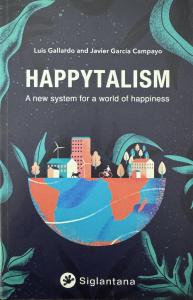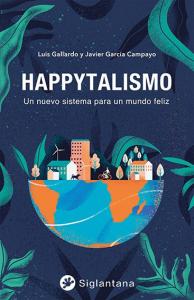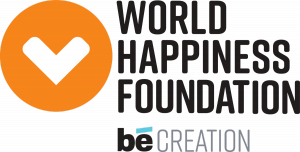Beyond Scarcity: Embracing Happytalism for a World of Abundance
Reframing the SDGs to New Happytalist Goals. A New Roadmap for a Flourishing World
Yes—people suffer material lack. Happytalism does not deny constraints; it challenges the mental model that locks in scarcity patterns.”
MIAMI, FL, UNITED STATES, August 22, 2025 /EINPresswire.com/ -- In 2015, the United Nations launched 17 Sustainable Development Goals (SDGs) to mobilize the world around poverty eradication, health, education, equality, climate action, and more. Framed as an urgent call to “end” or “reduce” concrete deficits, the SDGs have galvanized unprecedented attention and cooperation. Yet their deficit‑oriented language can unintentionally reinforce a worldview of lack—one that measures progress mainly by what is eliminated rather than by what is created. In this reading, development becomes a zero‑sum contest over finite resources. — Luis Miguel Gallardo
World Happiness Foundation
The World Happiness Foundation proposes a complementary paradigm—Happytalism—that shifts the center of gravity from scarcity and problem‑fixing to abundance, well‑being, and what we want to cultivate. Rather than asking how to fight what’s wrong, Happytalism asks how to build what’s right: systems that unlock human potential, regenerate nature, and expand shared prosperity. It argues that the next breakthrough in global progress is not only technical or financial; it is mindset—a collective movement from fear and competition to trust, collaboration, and joy.
Why scarcity framing constrains progress
A scarcity mindset treats life as a finite pie: if someone else gains, I lose. In policy and practice, that shows up as:
Short‑termism. When leaders fear there isn’t enough to go around, they chase quick wins—over‑extracting natural resources, prioritizing near‑term profits, or cutting preventive investment—undermining the very sustainability they seek.
Fear and protectionism. Scarcity feeds “us vs. them,” nationalism, and hoarding (e.g., vaccines or technology), which blocks solutions to problems that require trust and cooperation across borders.
Entrenched inequality. If powerholders believe wealth is zero‑sum, they resist sharing, reform, or redistribution; aid comes with strings, and structural change stalls.
Burnout. Fighting 17 problems framed as emergencies can feel like plugging leaks in a dam. People lose energy when everything is a battle, not a shared building project animated by a hopeful vision.
This critique does not reject the SDGs’ moral clarity or targets; it reframes how we approach them. The Foundation’s view is that the SDGs brilliantly name the what, but to realize them we must upgrade the how and the why—toward an abundance‑based, well‑being‑centered pathway.
Happytalism in brief
Happytalism is presented as a development philosophy oriented to the systematic pursuit of well‑being for all—individual and collective. Its north star is Fundamental Peace, defined as the convergence of freedom, consciousness, and happiness—not merely the absence of conflict but the presence of inner liberty, awareness, and joy.
Three pillars distinguish the paradigm:
Abundance mindset. Technological progress and human creativity already make it possible to meet everyone’s basic needs; the binding constraint is our assumptions and governance, not the planet’s absolute capacity. An abundance lens asks, “How do we unleash creativity and compassion to generate more value for everyone?” rather than “How do we divide scarcity?”
Interdependence and oneness. Humans are inseparable from one another and from nature. As science and contemplative traditions both suggest, what we do to the web of life we also do to ourselves. Policies and markets must therefore align with ecological regeneration and social cohesion, not just output growth.
Inner + outer development. The SDGs lean toward external conditions (infrastructure, services, laws). Happytalism adds inner work—mindfulness, compassion, purpose, and positive psychology practices—because resilient, self‑aware people and communities sustain healthier systems. In this view, Bhutan’s Gross National Happiness metric is not an outlier but a harbinger of smarter progress measures.
From SDGs to Happytalist Goals
The Foundation’s proposed Happytalist Goals mirror the SDGs issue‑by‑issue while reframing each one in the language of creation and flourishing. Below is the one‑line shift for each goal (retaining the SDG numbering for continuity):
Abundant Prosperity for All (SDG 1 → No Poverty): Make thriving, not merely subsistence, the design principle—through fair distribution, generosity, and well‑being‑centered economies.
Holistic Nourishment & Health (SDG 2 → Zero Hunger): Guarantee nutritious food and clean water for all via sustainable agriculture and mindful consumption that honors bodies and spirit.
Holistic Health & Happiness (SDG 3): Integrate physical, mental, and emotional well‑being; measure success in lives improved and joy spread, not only diseases averted.
Mindful Education & Lifelong Learning (SDG 4): Educate the whole person—critical thinking and compassion, creativity and consciousness—for citizens who can co‑create a happier society.
Inclusive Equality & Empowerment (SDG 5): Uphold the equal worth of every person; elevate both feminine and masculine qualities; ensure marginalized groups can shine.
Water & Wellness for All (SDG 6): Treat clean water and sanitation as non‑negotiable rights; invest in nature‑based solutions and resilient community systems.
Renewable Energy Abundance (SDG 7): Power progress with sun, wind, and water; close access gaps so energy equity becomes a foundation for flourishing.
Meaningful Work & a Well‑Being Economy (SDG 8): Favor purpose over mere profit; judge success by Gross (Global) Happiness and well‑being indices, not output alone.
Conscious Innovation & Quantum Progress (SDG 9): Guide tech and infrastructure by conscious intent and equitable sharing—exponential change in service of life.
Shared Prosperity & Social Justice (SDG 10): Reduce inequality through inclusive design and fair policy, recognizing that others’ success expands collective well‑being.
Happy & Harmonious Communities (SDG 11): Plan cities for belonging—green spaces, cultural life, social connection, and easy access to well‑being services.
Mindful Consumption & Regeneration (SDG 12): Shift to circular, restorative production and lifestyles that prioritize quality of life over quantity of stuff.
Planetary Well‑Being & Climate Balance (SDG 13): Restore climate harmony through joyful, collective action and a rapid transition to clean energy.
Flourishing Oceans & Marine Unity (SDG 14): Treat oceans as sacred; end pollution and overfishing; recover blue ecosystems as a shared life‑support.
Interspecies Harmony & Biodiversity (SDG 15): Protect forests and wildlife as family; ensure human progress never advances at the expense of other beings.
Peaceful Coexistence & Conscious Governance (SDG 16): Build institutions anchored in empathy, forgiveness, and transparency, with Fundamental Peace—freedom, consciousness, happiness—as the guiding star.
Global Unity & Collective Action (SDG 17): Nurture a global family ethos where cross‑sector collaboration multiplies impact for a shared abundant future.
This reframing keeps the SDGs’ substance but replaces “ending deficits” with creating positives. It assumes abundance is possible—and, with the right choices, inevitable—and anchors strategies in interdependence over competition.
Momentum: where abundance is already emerging
The shift is not theoretical. Countries experimenting with well‑being economies (e.g., New Zealand and Scotland) show how budgets can be designed around life outcomes rather than GDP alone. Bhutan’s Gross National Happiness remains a pioneering example of measuring what truly matters. Schools worldwide are adopting social‑emotional learning and mindfulness to develop whole adults, not just test‑takers. Environmental innovators are scaling regenerative agriculture and circular production, while movements to recognize the rights of nature signal an expanding ethical circle. These real‑world efforts rhyme with the Happytalist Goals and prove that “abundance logic” works in practice.
How an abundance lens changes the playbook
Adopting Happytalism doesn’t replace hard policy with “positive thinking.” It changes the questions and, therefore, the strategies:
From minimizing harm to maximizing good. Instead of only mitigating poverty, hunger, or emissions, design for thriving: community wealth‑building, dignified work, food sovereignty, and carbon‑positive landscapes.
From zero‑sum to win‑together. Replace extractive competition with cooperative advantage. Share technology and know‑how so breakthroughs spread faster and lift many boats, not just the first movers.
From top‑down programs to whole‑system activation. Pair inner development (mindset, meaning, mental health) with outer transformation (infrastructure, regulation, incentives). Policymakers, businesses, schools, and civil society each carry part of the change.
From GDP‑only to multi‑capital accounting. Track well‑being, social cohesion, mental health, biodiversity, and resilience alongside income—because what we measure shapes what we create.
Putting Happytalism to work (practical pathways)
1) Individuals → “Rousers,” the conscious catalysts.
Happytalism names everyday leaders Rousers—people who model abundance in action. Practices like gratitude, mindfulness, and strengths‑based service help rewire personal outlooks from fear to possibility. Begin small: convene a neighborhood happiness circle; start a community garden; initiate well‑being conversations at work; mentor youth with a growth‑and‑care mindset. Personal shifts ripple outward.
2) Communities and cities.
Design for belonging: pocket parks and greenways within a short walk; co‑ops and time banks that keep value local; arts and cultural spaces that stitch social fabric; universal access to clean water, sanitation, and mental‑health support. Treat planning and budgeting as projects in joyful, shared quality of life rather than merely “services delivery.” (Happytalist Goals 6, 11, 12.)
3) Enterprises.
Evolve from “human resources” to human flourishing. Align compensation and governance with long‑term well‑being and environmental balance. Adopt regenerative operations, publish a happiness or well‑being impact statement, and invest in employee mental health and learning journeys. Redesign product portfolios to solve real problems and create delight, not just demand. (Happytalist Goals 8, 9, 12.)
4) Education systems.
Make mindfulness, social‑emotional learning, and purpose discovery core to curricula. Train teachers as coaches; make schools laboratories for compassion, creativity, and community leadership. Extend learning across the lifespan through community‑based academies and open credentials. (Happytalist Goal 4.)
5) Public policy.
Institutionalize abundance via:
Well‑being budgets that allocate funds to what drives life satisfaction and resilience;
Rights‑of‑nature and biodiversity protections that honor interspecies kinship;
Clean‑energy access as a universal right and foundation for opportunity;
Equity policies that shrink gaps by choice (e.g., progressive services access, fair taxation, universal basic services); and
Open knowledge mechanisms that spread solutions across borders. (Happytalist Goals 7, 10, 13, 15, 17.)
6) Measurement and narrative.
Shift from problem‑saturated messaging to aspirational storytelling anchored in evidence. Track not only “problems reduced” but “goods created”: thriving small businesses, time in nature, trust in institutions, local volunteerism, reductions in loneliness, and increases in perceived meaning and joy. Metrics shape behavior; stories shape culture.
Addressing understandable doubts
“Isn’t scarcity real?”
Yes—people suffer material lack. Happytalism does not deny constraints; it challenges the mental model that locks in scarcity patterns. The claim is that abundant solutions already exist or can be created—shared clean energy, regenerative food systems, cooperative finance, digital public goods—if we coordinate and choose them. The practical difference is that abundance starts by asking how to grow the pie together, not how to ration it in fear.
“Won’t this be naïve about politics?”
Power dynamics matter. An abundance lens still requires real policy: transparent institutions, anti‑corruption, fair rules of the game, and voice for marginalized communities. The shift is to conscious governance that pairs accountability with empathy and conflict transformation. (Happytalist Goal 16.)
“What makes Happytalism different from ‘doing the SDGs better’?”
Two things: (1) Positive creation replaces deficit‑only framing; and (2) inner development is treated as a public good that unlocks outer systems change. It’s an upgrade of the SDG operating system, not a rejection of its applications.
A practical map for the next chapter
To operationalize the shift, organizations can:
Adopt the 17 Happytalist Goals as design prompts alongside the SDGs. For any initiative, articulate the positive state you’re creating (e.g., “Meaningful Work & a Well‑Being Economy” vs. merely job counts).
Build inner‑outer learning loops. Pair well‑being practices (mindfulness, peer circles, coaching) with performance reviews and team rituals. Track effects on trust, creativity, and retention.
Budget for belonging. In cities and campuses, dedicate funds to green spaces, community kitchens, arts, and third places—small investments with large social‑cohesion returns. (Happytalist Goal 11.)
Measure what matters. Pilot well‑being dashboards and happiness surveys; align incentives to well‑being outcomes. (Happytalist Goals 3, 8.)
Partner across sectors. Treat Goal 17 as the engine of abundance: public‑private‑community alliances that share data, learnings, and platforms so solutions replicate quickly.
The invitation
The World Happiness Foundation closes with a call to become “conscious catalysts”—Rousers who embody abundance and help weave a global community of practice. The SDGs gave the world a unifying story about tackling crises. Happytalism offers a complementary story about cultivating a world where freedom, consciousness, and happiness are the fabric of everyday life. The case is both visionary and practical: aim for flourishing, design for belonging, invest in well‑being, and coordinate at scale.
If, by 2030, we have not only hit key SDG targets but also elevated how people feel—more empowered, more connected, and more joyful—we’ll know we chose abundance wisely. That choice begins in our own hearts and spreads through our policies, classrooms, companies, and neighborhoods. The future we seek is already latent in us; Happytalism is an invitation to release it—together.
World Happiness Foundation: https://worldhappiness.foundation/blog/consciousness/beyond-scarcity-embracing-happytalism-for-a-world-of-abundance/
Paul Hamilton
World Happiness Foundation
+1 347-606-5317
email us here
Legal Disclaimer:
EIN Presswire provides this news content "as is" without warranty of any kind. We do not accept any responsibility or liability for the accuracy, content, images, videos, licenses, completeness, legality, or reliability of the information contained in this article. If you have any complaints or copyright issues related to this article, kindly contact the author above.



